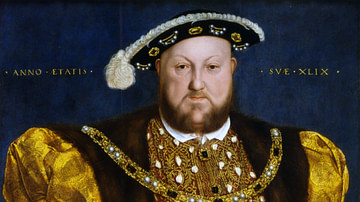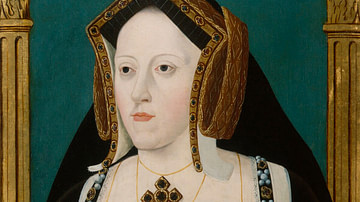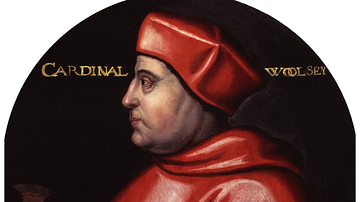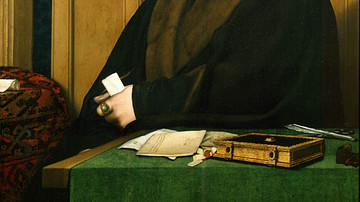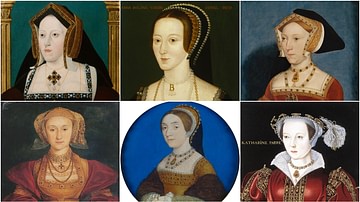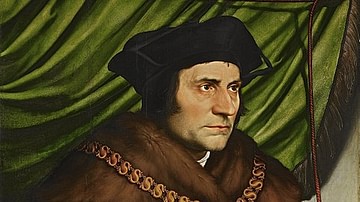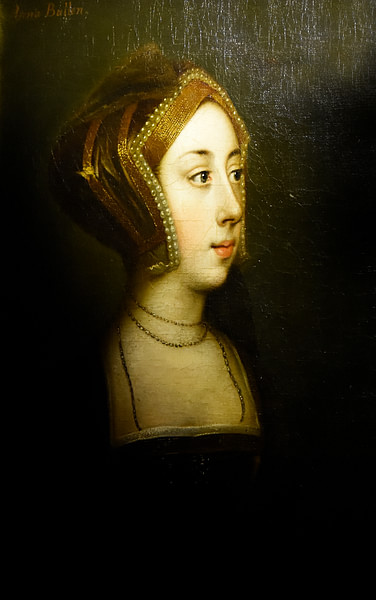
Anne Boleyn (c. 1501-1536) was the second wife of Henry VIII of England (r. 1509-1547). Anne, sometimes known as 'Anne of a Thousand Days' in reference to her short reign as queen, was accused of adultery and executed in the Tower of London in May 1536.
Henry was able to have Anne as his queen when his first marriage to Catherine of Aragon (1485-1536) was finally annulled after much palaver in 1533. Still in search of an heir, the king was to be disappointed again when Anne gave birth to a daughter, Elizabeth, the future Queen Elizabeth I of England (r. 1558-1603). The execution of Anne, a final brutal act of an ill-fated marriage, left Henry free to marry his third wife, Jane Seymour, and continue his search for a male heir.
Catherine of Aragon
Henry VIII (b. 1491) had married the Spanish princess Catherine of Aragon in June 1509. Catherine had married Henry's elder brother Arthur in 1501 but the prince had died the next year. Henry's marriage seemed a happy one in its early years but of the queen's six children, only one survived infancy, a girl, Mary, born in February 1516. Henry, meanwhile, had an illegitimate son, Henry Fitzroy, Duke of Richmond (b. 1519), with a mistress, one Elizabeth Blount, and so the king began to blame his queen for not producing a healthy and legitimate male heir. Catherine was six years older than Henry and the age difference began to tell by the mid-1520s; the king was eager for a younger wife who could bear him a son. Annulling his marriage, what the king called his 'great matter', would, though, prove to be difficult and have far-reaching consequences.
From around 1526, Henry VIII's eye was caught by the beautiful lady-in-waiting Anne Boleyn, younger sister of Mary Boleyn, one of his former conquests. Anne was born c. 1501, the daughter of Sir Thomas Boleyn (future Earl of Wiltshire) and Elizabeth Howard, the daughter of Thomas Howard, Duke of Norfolk. She even had a royal connection as her aunt was the youngest daughter of Edward IV of England (r. 1461-1470 & 1471-1483). In her youth, Anne lived in the family home, Hever Castle in Kent, and was then educated in the Netherlands and at the French court. Anne joined King Henry's court in 1522.
Dark-haired, slim, and sophisticated, Anne, clever enough to realise she was about to become a pawn in a game of thrones, declined Henry's courting gifts of jewels and refused to sleep with the king until they were married. To this end, Henry wrote a letter to Pope Clement VII (r. 1523-1534) in 1527 suggesting that the lack of a male heir was God's punishment for Henry marrying the wife of his late brother, a point supported by the Old Testament (the 'Prohibition of Leviticus', Leviticus ch. 20 v. 21). Consequently, the king wished for the Pope to annul the marriage as it should never have been allowed in the first place.
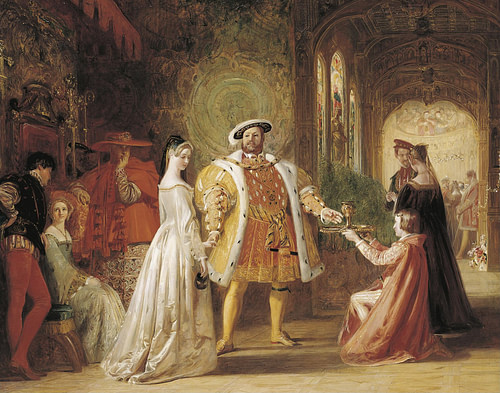
Henry's next tactic was to permanently separate Catherine from her daughter Mary and shift her about the country to various dilapidated residences, although this did not quell the queen's popularity amongst the people. Meanwhile, Henry and Anne Boleyn lived together (but did not sleep together). Anne was given the title Marquess of Pembroke with matching estates and income. The king was sufficiently confident of his moral position to travel to France with Anne as his official consort in October 1532. Sometime in December 1532, Anne, perhaps seeing a baby as the best way to rid herself of her rival Catherine, did sleep with the king and became pregnant.
A Divided Church
A new Archbishop of Canterbury, Thomas Cranmer, who was also keen to split the English Church from Rome, formally annulled Henry's first marriage on 23 May 1533. Cranmer had also been the chaplain of Anne's father in 1529. With the passing of the Act in Restraint of Appeals by Parliament (drafted by Cromwell), Catherine had no recourse to any appeal. The decision was final. The annulment and Parliament's passing of the Act of Succession (30 April 1534) meant that Catherine's daughter Mary was declared illegitimate, loyalty was sworn to Queen Anne, and any of her offspring recognised as official heirs to the throne. Catherine was forbidden from using the title 'Queen of England' and had to instead use 'Princess Dowager'. Catherine, effectively living under house arrest, died of cancer in January 1536.
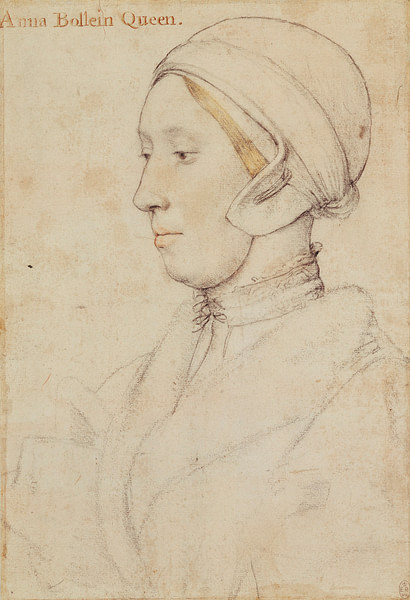
Marriage & Daughter
Henry had married Anne in secret on 25 January 1533, even before his first marriage was officially annulled. The pressure had really been on since a child born out of wedlock would not be recognised by everyone as the king's legitimate heir. Anne, by then heavily pregnant, was crowned Queen of England on 1 June 1533. However, the public's support of Catherine was still evident as some elements of the crowd jeered Anne on her way to Westminster, chanting 'Nan Bullen shall not be our Queen!' Anne was, no doubt, unperturbed; she had gained what she had always wanted as she rode in a golden carriage and wore a scarlet robe heavy in pearls and jewels, ready to meet her destiny.
Anne was by no means a passive element of the royal court. Well-educated and a believer in church reform, she patronised scholars and reformers, supported distribution of translations of the Bible in English, and imported and circulated evangelical books. It was through Anne's influence that such reformist figures as Hugh Latimer and Nicholas Shaxton were made bishops. The queen also aided the poor and was an advocate of social reform.
On 7 September 1533, Anne gave birth to a daughter, Elizabeth. There would be other pregnancies, but these infants were lost, two via miscarriages (1534 and 1535) and one stillborn boy (1536). Henry, once again, began to blame his wife for the lack of a male heir. The royal relationship deteriorated with the headstrong Anne openly insulting the king at court and whispers abroad that the English king had married no higher than a common prostitute. The fate of Anne was about to follow a similar road to her predecessor with Henry's roving eye now on the lookout for wife number three, a realistic option following the death of Catherine in 1536.
Trial & Execution
When the king discovered that Anne had had an affair, or perhaps simply because his lust was already being satisfied by another lady-in-waiting at court, Jane Seymour, he ordered Anne's arrest. The queen was confined to the Tower of London on 2 May 1536, poignantly, in the very same chambers she had stayed in prior to her coronation. The case against the queen was trumped up by Thomas Cromwell, most likely because Anne had not produced a healthy male sibling to accompany Elizabeth and the king had tired of their turbulent relationship. Cromwell was aided in his search for spurious evidence against the queen by the strong pro-Catherine faction still at court, which had not forgotten the shabby treatment of their Catholic champion. Just for good measure, Cromwell added a whole load of other charges, too. These included incest with her own brother, Lord Rochford, affairs with at least four lovers, attempted murder by poison of her husband, and even witchcraft. A confession and implication of others was extracted under torture from Anne's favourite musician, one Mark Smeaton, but Anne herself denied all of the charges, as did all the other 'lovers'.
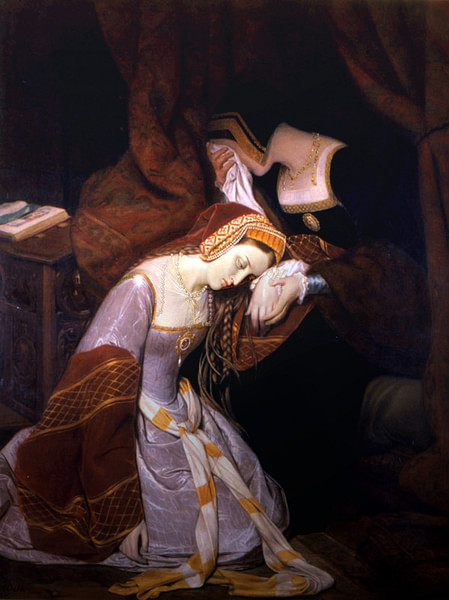
I think you know well the reason why you have condemned me to be other than that which led you to this judgement. My only sin against the King has been my jealousy and lack of humility. But I am prepared to die. What I regret most deeply is that men who were innocent and loyal to the king must lose their lives because of me.
(Jones, 180)
The queen offered to retire to a nunnery if Henry would show mercy, but he did not, his only concession being that the queen should be beheaded and not burned at the stake as witches traditionally were. Anne was granted a last request of having a specialist executioner come from France who decapitated Anne with a sword rather than the usual axe which could sometimes require a few blows to achieve its terrible purpose. On 19 May 1536, before the blade fell, Anne was said to have proclaimed:
The king has been good to me. He promoted me from a simple maid to a marchioness. Then he raised me to be a queen. Now he will raise me to be a martyr.
(quoted in Philips, 103)
Anne's brother and her accused lovers had also been executed, two days before the queen. Princess Elizabeth, like her half-sister Mary, daughter of Catherine of Aragon, was declared illegitimate. All traces of Anne, from monogrammed cushions to portraits, were removed from all the royal palaces. Within two weeks, Henry married his third wife, Jane Seymour, and she finally gave the king a son, Edward, born on 12 October 1537. The long-awaited arrival of a male heir sparked off gun salutes, bell-ringing, and banquets across England. Tragically, Jane died shortly after and Henry would go on to have three more wives. When Henry died of ill health in 1547, he was succeeded by his juvenile and still only son Edward VI of England (r. 1547-1553) who, thanks to wars and the crisis of Henry's first marriage, only inherited an impoverished kingdom deeply divided over religious issues.
